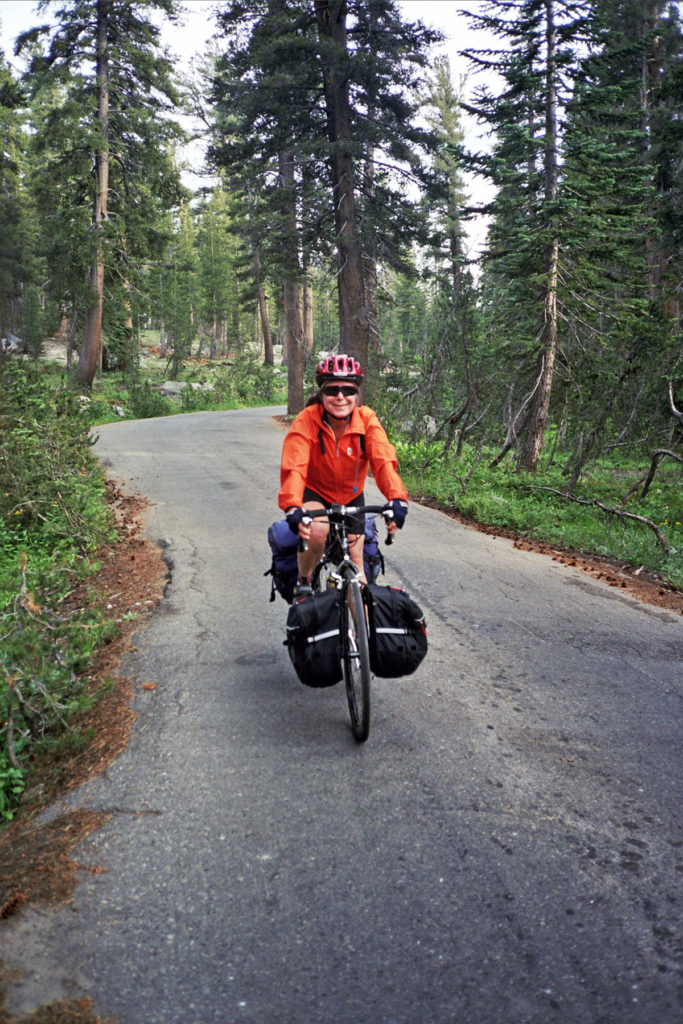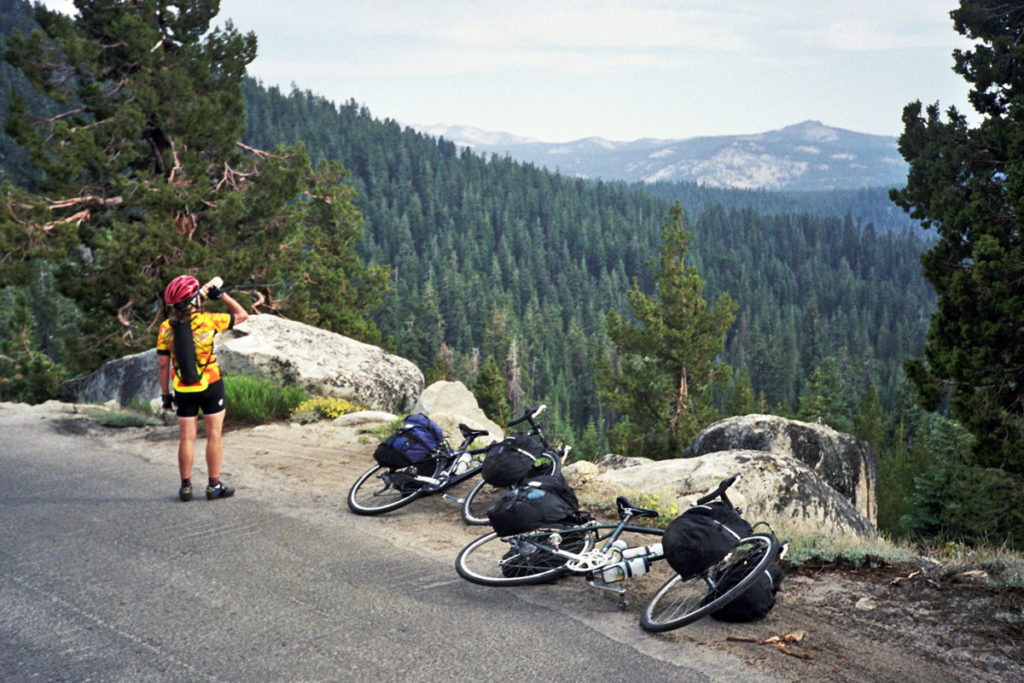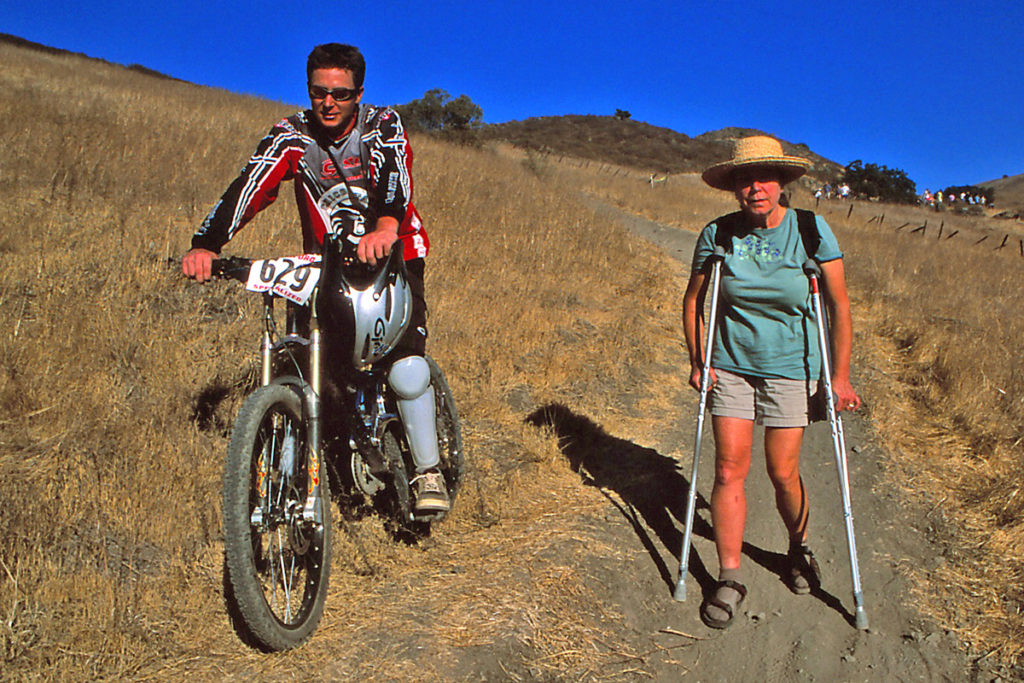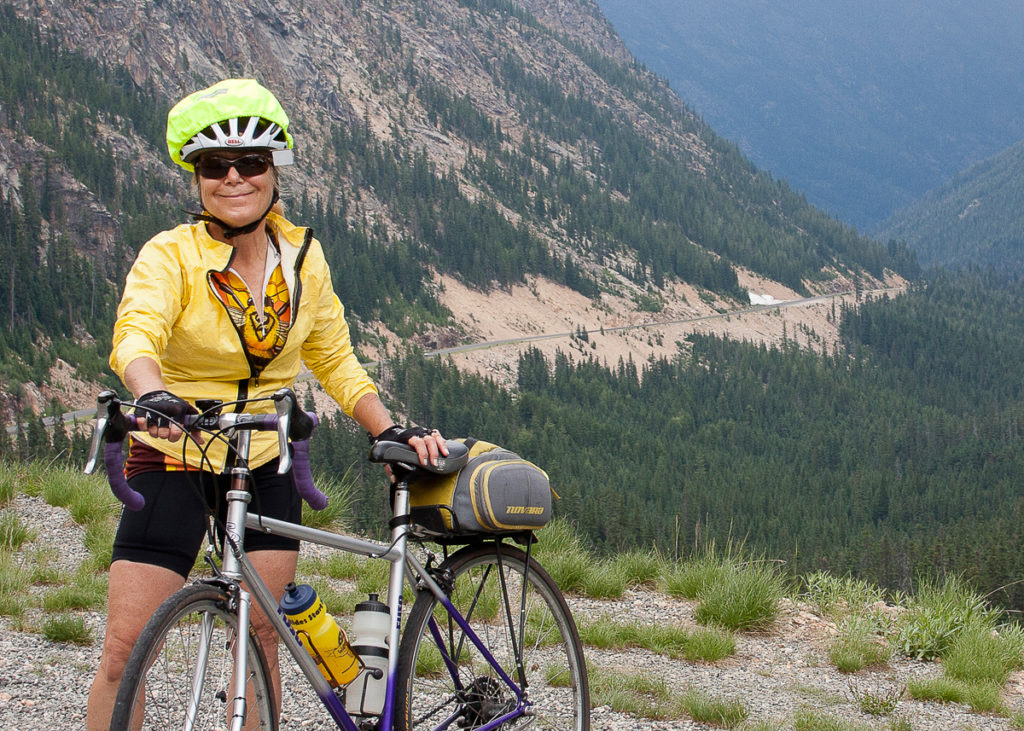By Howard Shafer – “Howard, I can’t stop!” Jacquette had screamed, careening past me, her bicycle plunging down the mountain road and then disappearing around a curve. We had already pedaled 77 miles and climbed over 9200 feet. With the climbing behind us, we were supposed to be on the easy part, coasting down the far side of Kaiser Pass and looking forward to long, soothing soaks in Mono Hot Springs.

I tried to catch up to her. My bicycle pounded over the rough pavement. My heart hammered.
“Use your brakes!” I yelled at the empty road, knowing even then how stupid I sounded. A cyclist as experienced as my wife needed to be told about braking?
I tore after her, but I could not catch her until I flew around one last curve and found a hulking, black SUV blocking my path. Beyond it, she lay motionless, her bicycle crumpled, her panniers scattered. Let her be alive, I prayed, leaping from my bike and dropping to my knees beside her.
Her right leg bulged where there should be no bulge. One foot dangled at an ugly angle. Rivulets ran from beneath her deathly still body across the black asphalt and pooled at the edge of the road.
My brain could not wrap itself around what my eyes were seeing. Had I lost forever the woman who had become the heart and center of my life?
That was Saturday, July 20, 2002.
Long ago, doctors had straightened and then fused most of her vertebrae together. In 1960, that’s how they treated the unnatural spinal curvature called scoliosis. When they wrapped her torso in that claustrophobic cast, she had been a twelve-year-old girl. When they finally removed it almost a year later, she discovered, like a beautiful butterfly emerging from its chrysalis, that she had become a woman. Because of her rigid, newly-fused spine, she was never allowed to participate in sports, and until she discovered bicycling, she had just assumed she never could.
A Backroads sponsored bicycle tour through California wine country changed everything. She’d signed up because she wanted to meet new friends after she made the long move from West Virginia to California. Wouldn’t a SAG always be available if the bicycling proved too hard? But already on the very first day, she discovered how much she loved this new sensation of physical exertion as well as the exhilaration she experienced with the bike beneath her and the miles disappearing behind her. She never used the SAG. When she returned home, she began bicycling the twenty miles round trip to work.
The first time we met, we were standing in the food line at a bicycle club Christmas potluck party. She smiled up at me and said I had to try the Chinese salad she’d brought, but when we reached the banquet table, others had already tried every bit of it, and there was none left for us. She claimed this meant she had to make more just for me. Our honeymoon was a 500-mile bike ride in the Canadian Rockies. Soon we were taking all our vacations on bicycles. “I have to bicycle,” she told me. “How would I survive if I gave it up?”
In the hospital, my wife lay tangled in the sheets, her right arm trussed in a blue sling and her right leg hidden by a bulging brown cast. Spiked lines glided across a flickering screen on the blue box behind her bed. Her eyelids fluttered, and she managed a weak smile. I could no longer control the tears clouding my vision. That’s when the doctor, frowning at the image of her fused spine on the x-ray before him muttered, “She should never have been on a bike in the first place.”
I could not stop the anguish in my heart. Had I not tried to surprise her on our seventh wedding anniversary with this foolish trip over the 9176-foot high Kaiser Pass with its narrow and steep roads, she would not now be lying so helplessly in that hospital bed.
Over and over, I relived the nightmare.
Yesterday we had been following delightful, undulating country roads that rolled uphill out of Fresno, first through cool orchards and then through hills warmed by summer. Our bicycles were loaded down with sleeping bags, clothes, stove, pots and pans, tent, and food, but our spirits soared.
Then everything changed. In the distance ahead, shimmering in the heat, we could see a long gash slicing upward across the mountain: the steep 8.5 mile long CA168 grade to Pine Ridge. We got ready for the climb but were unprepared for the road construction that forced us to share the shoulder of the highway with big SUVs driven by tired and sullen vacationers. Monstrous dump trucks roared past. Giant paving machines spewed hot asphalt. Acrid fumes rose around us. Construction noise reverberated through our brains. The temperature climbed toward one hundred degrees.
Then a truck stopped, and the driver offered us a lift. We accepted gratefully and collapsed, exhausted among a load of plastic cones. He dropped us off at the Buckeye Heliport at the top of the construction zone, where we had a spectacular view of the city of Fresno far below us. We congratulated ourselves that the nightmare was now behind us. We did not know how prophetic his choice of drop-off site would be.
Later, when we watched the shimmering gold and orange sunset from our tent on Shaver Lake, everything seemed worth it. We had bicycled fifty miles and climbed 5000 feet.

By mid-afternoon the next day, the temperature had passed one hundred degrees again. Pickup trucks pulling speedboats crowded us on the narrow highway. We reached Kaiser Pass about six in the evening on a steep, one lane road, exhausted again, but elated. We marveled at the view: to the west the rich Central Valley smoky with haze, to the east jagged peaks, below us a quiet lake in a lush meadow.
We took photographs and began the descent. After pausing near the lake, breathing in its stillness and marveling at the beauty of this perfect bit of nature, we started down again. I was a little ahead.
Then it happened. She came streaking past me out of control. She might have reached fifty miles per hour before meeting the SUV and failing to pass between it and the roadside boulders. Later she insisted her brakes had failed, but the bike was new.
When I reached her, the world seemed to move in slow motion, somebody else’s world, not mine. This was only a dream. Or a nightmare. I unbuckled Jacquette’s shattered helmet with shaking hands. Her eyes flickered, and she moaned.
Vehicles began to stack up along the road. Spectators collected. Someone phoned for help. She needed a helicopter, but no helicopter came. As the sun set over the mountains, Jacquette began to shiver, but the sleeping bag a good Samaritan donated helped a little. After endless waiting, an ambulance arrived and brought bad news. No helicopter was available that could land at 9000 feet.
So the ambulance carried us forty miles back over Kaiser Pass and down the other side of the mountain to the Buckeye Heliport. Twilight faded. Blackness leaned toward us from all sides. Loaded pickup trucks with blinding headlights whined toward us on the narrow road. We edged around them, teetering on the black edge of nothing.
At the heliport, a helicopter waited, its big rotors whooshing, its fuselage illuminated by the glow of Fresno city lights below us. The EMTs rushed Jacquette into the helicopter, and with a loud thumping sound, it rose into the blackness and then slid downward toward Fresno.
Jacquette had broken the tibia and fibula above her right ankle and fractured her right elbow. She had broken ribs and wrenched her back with its fused vertebrae. But she was alive, and I was grateful. The many directions of the abrasions on her helmet told me she had flipped and bounced more than once, but her head and neck were not injured, and the rivulets running down the road were only water from her Camelbak. The doctors pinned her leg together with a rod and screws and secured her elbow with a plate. Because her right side could not bear weight, she had to learn to maneuver a wheelchair using only her left hand and left foot. Unfortunately, little could be done for her wrenched back, and even today, when it does not receive attention, it begins to spasm. Sometimes she cannot stand up straight.
I don’t know what I would do, if I experienced such a horrific accident, but now I know what Jacquette would do. I also know what she would not do. She would not give up bicycling.

Ten weeks after her accident, she got out of her wheelchair and began riding a stationary bicycle. The next week she hobbled up a trail on crutches to watch her son compete in a mountain bike race. Fifteen weeks to the day after her accident she demanded I accompany her on a twelve-mile bike ride. Soon she was bicycling to work again, a round trip that had grown to thirty miles. The next spring she rode the six-day, 480 mile Go Greenbelt! bicycle tour around San Francisco Bay. She rode it again two years later. In 2008 she persuaded me to bicycle 520 miles down the California coast from Los Gatos to San Clemente to visit her dad. In 2012 we bicycled for a week through the North Cascades on a trip sponsored by Adventure Cycling. Our July wedding anniversary almost always includes a multi-day cycling trip to somewhere. Now, in 2016, she is still looking for new bike riding challenges.
We never learned why she couldn’t stop. A few hours before the accident, she had begun creeping numbly even on the downhills at not much more than five miles per hour. We realized she was exhausted, and we finally stopped for a nap at the side of the road. I’m sure the nap was not enough, and it’s possible exhaustion clouded her thinking. She thought she was braking, but she wasn’t. She refuses to accept this theory, but no one has a better one.
Perhaps the doctor was right. She should never have been on a bicycle in the first place, but she was, and to this day, she still is.


